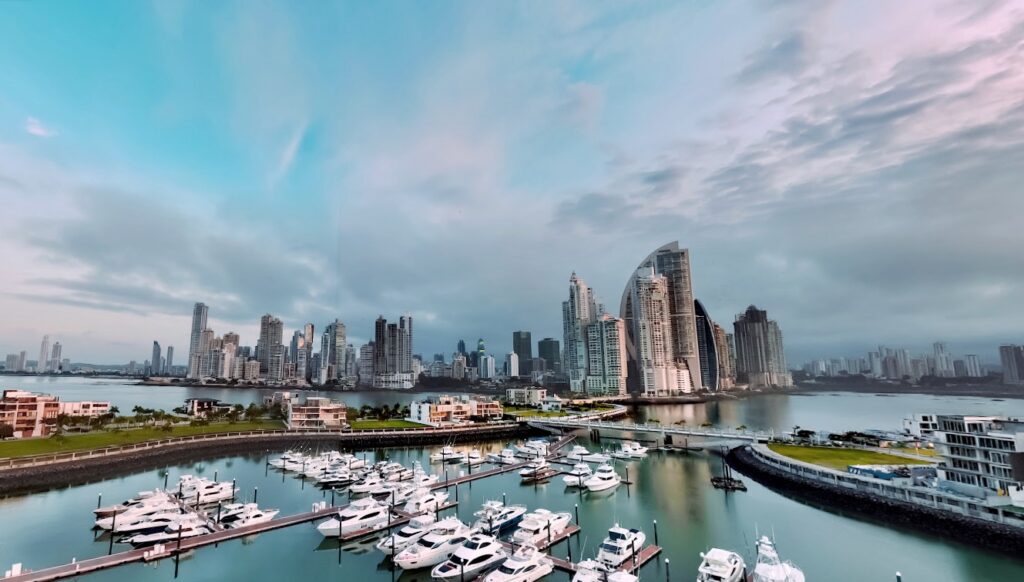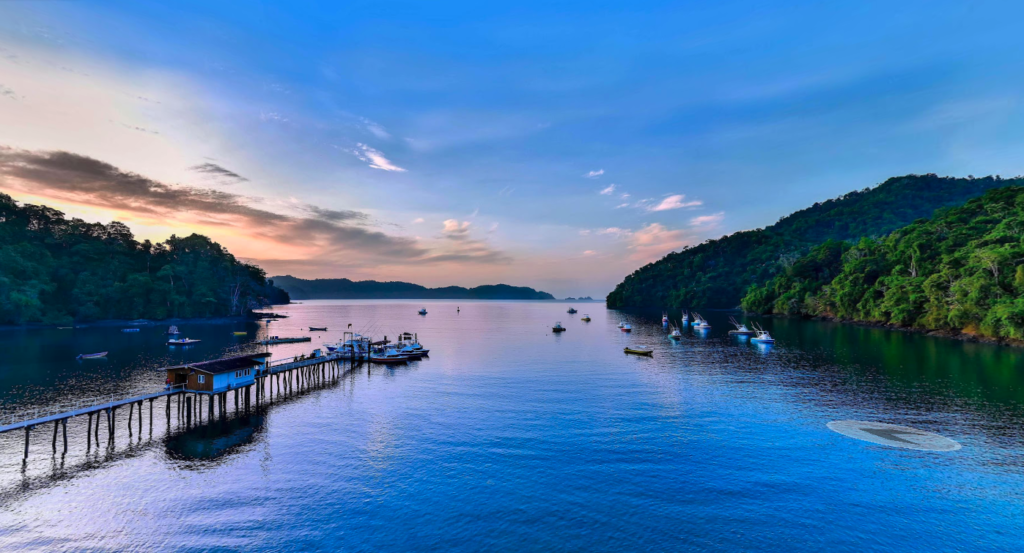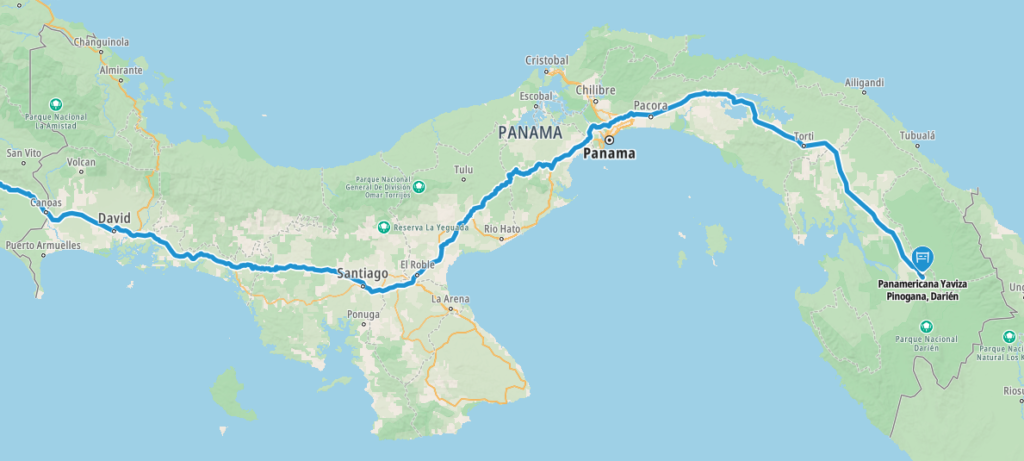Panama / Republic of Panama / República de Panamá – Let’s explore here

What’s it like in Panama?
Panama is a country in central America, about one third the size of the United Kingdom. Throughout the centre lies the Cordillera de Talamanca mountains and hills. The highest point is the Volcán Barú, at 11,401 feet (3,475 m) above sea level. Panama is home to the famous Panama Canal – an artificial 51 mile (82 km) waterway which connects the Atlantic Ocean with the Pacific Ocean.
In the far east of the country on the border with Colombia, there is an impenetrable jungle that forms the Darién Gap, a heavily forested mountainous area that cannot be traversed by vehicle. The Darién Gap is the only break in the Pan-American highway.
Panama’s population is around 4½ million (2023) and its capital, about half of whom live in the capital, Panama City.

A bit about the history of Panama
Pre Columbian and Early Exploration
Before European arrival, Panama was inhabited by several indigenous groups, including the Kuna, Ngäbe-Buglé and Embera. Christopher Columbus arrived in Panama in 1502 during his fourth voyage, marking the beginning of European exploration in the region.
Spanish Colonisation
In the early 16th century, Panama was colonised by the Spanish, who established settlements such as Panama City in 1519. The area became an important transit point for Spanish expeditions, as it linked the Pacific and Atlantic Oceans. The indigenous population suffered greatly under Spanish rule due to disease, exploitation and warfare.
Independence from Spain
Panama was part of the Spanish Empire until the early 19th century. In 1821, Panama declared independence from Spain and joined the Gran Colombia federation, which also included present day Colombia, Venezuela, Ecuador, and parts of northern Peru. Panama remained part of Gran Colombia until the federation’s dissolution in 1831.
Part of Colombia
Following the breakup of Gran Colombia, Panama became part of Colombia. The two countries had a strained relationship, with Panama seeking greater autonomy. Tensions over issues such as trade, political representation, and the desire for independence grew over time.
The Panama Canal and US Influence
In the late 19th century, the idea of constructing a canal across Panama to connect the Pacific and Atlantic Oceans became a major international project. The French, under Ferdinand de Lesseps, initially attempted to build the canal in the 1880s but failed due to engineering difficulties and a high death toll from diseases like malaria and yellow fever. In 1903, with support from the United States, Panama declared independence from Colombia. The US then gained control over the Panama Canal Zone, a 10 mile (16 km) wide strip of land along the canal route. Construction of the canal resumed, and it was completed in 1914, greatly enhancing global trade and shipping.
Independence and the Canal Zone
Following its independence, Panama faced challenges in asserting its sovereignty, as the US retained control over the Panama Canal Zone. This arrangement led to political tension and periodic protests, as many Panamanians resented foreign control of the canal. Panama’s sovereignty over the Canal Zone was gradually restored through negotiations, culminating in the 1977 Torrijos-Carter Treaties, which stipulated the eventual transfer of the canal to Panama by 1999.
Military Rule and the US Invasion
In the 1960s and 1970s, Panama experienced political instability, with the military playing a significant role in the country’s governance. General Omar Torrijos took power in 1968 and ruled as a de facto leader until his death in a plane crash in 1981. During his rule, Torrijos implemented social reforms and negotiated the Torrijos-Carter Treaties, which paved the way for the canal’s transfer to Panama.
In the 1980s, Panama saw increased political and economic unrest, particularly under the leadership of General Manuel Noriega, who had gained power following Torrijos’ death. Noriega’s regime was marked by corruption, drug trafficking and human rights abuses. In 1989, after Noriega’s refusal to step down following disputed elections, the United States launched Operation Just Cause, a military invasion that removed Noriega from power and restored democratic governance.
Democracy and Modern Panama
After the US invasion, Panama transitioned to a democratic government, holding free elections in 1990. The country has since made significant strides in political stability, economic growth, and the expansion of its financial services sector. The Panama Canal was officially handed over to Panama on 31 December 1999. In the 21st century, Panama has continued to grow as a major financial and shipping hub, with the Panama Canal remaining a key asset for international trade. However, challenges such as income inequality, corruption and political tensions persist.


Panama road trip
Our Panamanian road trip is part of a much larger North American road trip.
Our planned Panamanian road trip takes us from Costa Rica, heading towards the capital, Panama City, and finally ending at the Darién Gap.
No doubt we’ll explore the country much more than this continent-spanning short route shows, in particular checking more of the coast and inland Panama.
Hopefully our journey will improve our knowledge of this intriguing and beautiful country, and enable us to meet some interesting people. We’ll be updating this page at that time – don’t forget to check back
Map of our road trip through Panama

What’s it like to drive in Panama?
We’ve also created a dedicated page to driving abroad, which you might find helpful 🙂
What currency do they use in Panama?
In Panama they use the Panamanian balboa and the US dollar, which are equal in value. Cash is widely used. The use of credit / debit cards is widely accepted in major cities, although not in rural areas. Travellers cheques are accepted in major cities only. There are many ATMs in cities, although not all accept foreign issued cards.
You should make yourself aware of the amount that your bank charges you for using credit and debit cards abroad. Often credit cards are cheaper for purchasing items directly, and for withdrawing cash from ATMs.
What language do they speak in Panama?
They speak Spanish in Panama. English is also spoken widely in major cities.
What time zone is Panama in?
Remember, when you’re planning your next trip to take a look at what time zone it’s in.
Do I need a visa to visit Panama?
We’ve created a dedicated, more comprehensive page on visas, which you should find helpful. Check it out!
Is wild camping legal in Panama?
Yes, wild camping is fine in Panama, although make sure the land is not private or being used for the cultivation of narcotics.
What plug / socket type do they use in Panama?
In Panama they use plug / socket types A and B.


Health issues in Panama
Is it safe to drink water in Panama?
Yes, it is safe to drink tap water in Panama. Bottled water is also readily available across the country.
What vaccinations are required for Panama?
This NHS website is kept up to date with all relevant information on vaccinations in Panama.
Phones in Panama
What is the country calling code for Panama?
The country calling code for Panama is +507
What are the emergency phone numbers in Panama?
- The emergency number for police in Panama is: 911 / 104
- In Panama, the emergency number for ambulance is: 911
- The emergency number for fire in Panama is: 911 / 103
If you’ve got some useful info that you’d like to share, let us know!
And don’t forget to check out all the other pictures!
